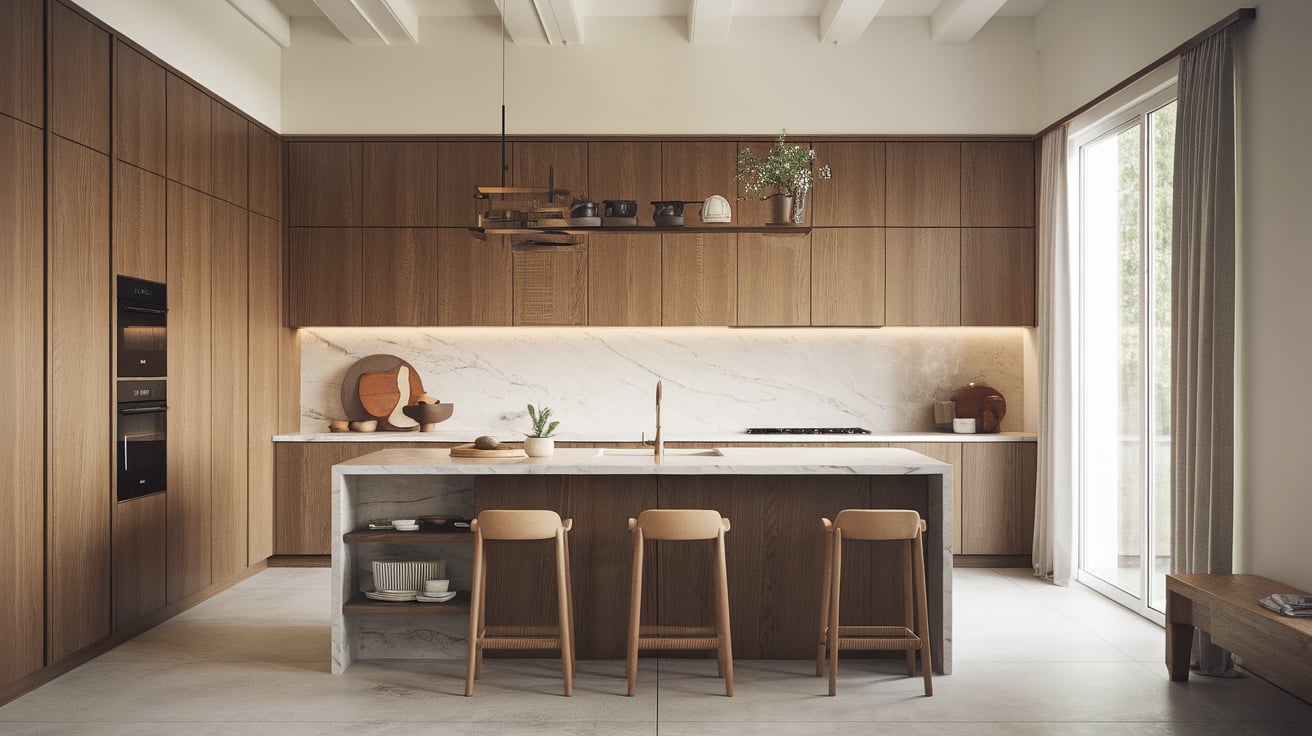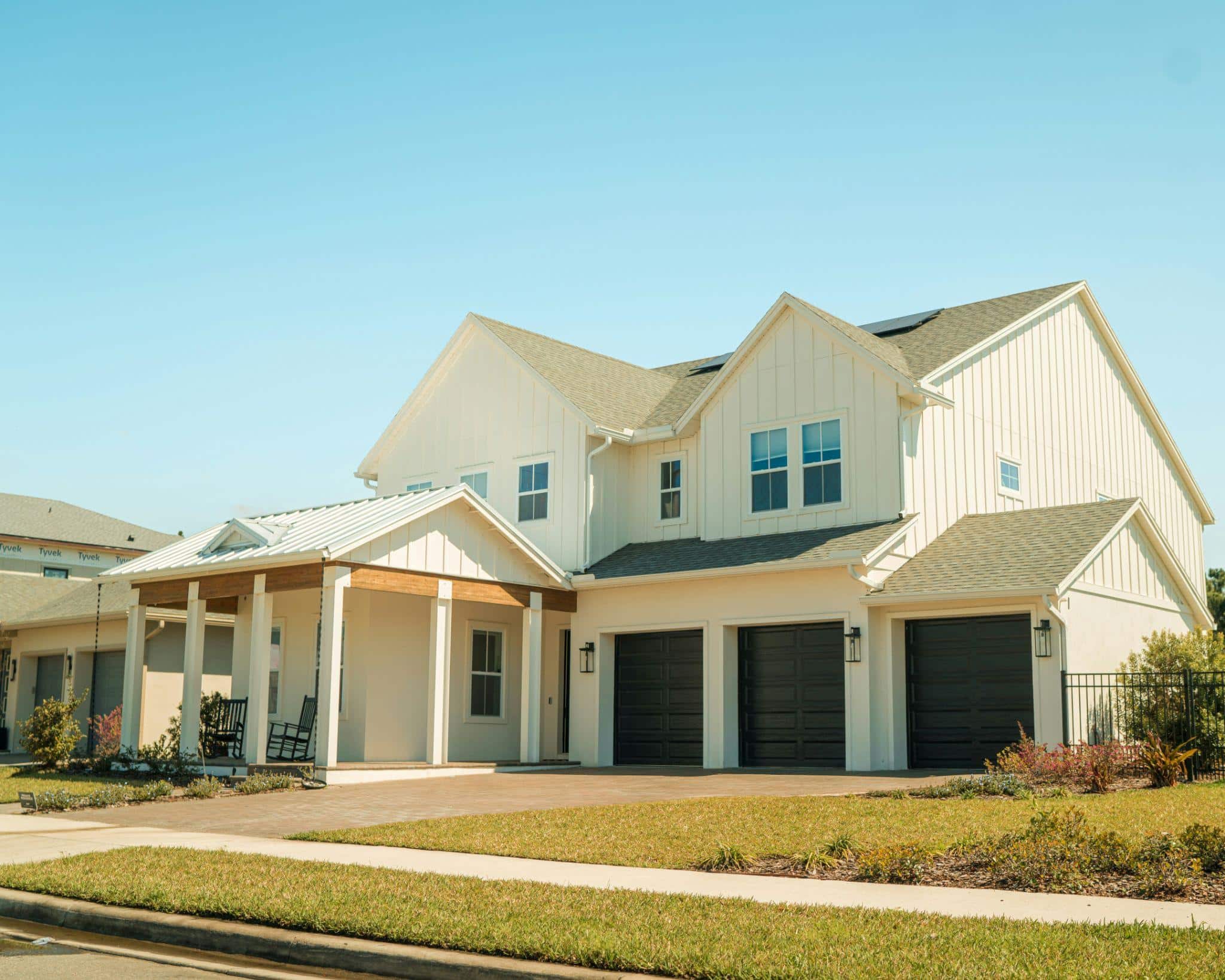Finding that perfect balance between function and style in a kitchen can be tough. Most kitchens either look too cold or too cluttered, making it hard to feel truly at home in your cooking space.
This post will show you how Japandi kitchen design solves this problem by blending Japanese minimalism with Scandinavian comfort – creating spaces that are both peaceful and practical.
Here are 19 Japandi kitchen ideas that combine clean lines, natural materials, and thoughtful details.
Whether you have a tiny apartment or a spacious home, these tips will help you create a kitchen that feels both calm and lived-in.
Why You Should Consider a Japandi Kitchen Look?
Kitchens tend to collect clutter faster than any other room. That’s why Japandi design works so well – it combines Japanese minimalism with Scandinavian practicality to create spaces that stay naturally tidy.
This blend focuses on quality over quantity, using natural materials like wood and stone that actually look better as they age. The clean lines and thoughtful organization make daily cooking less stressful because everything has its place.
This style removes visual noise without feeling sterile or cold. The neutral colors and natural textures create a gentle backdrop for cooking and gathering with friends.
What makes this style so practical is how it balances beauty with function. Open shelving displays just what you need, while clever storage hides everything else.
The result is a kitchen that feels both peaceful and useful – exactly what a cooking space should be.
19 Simple Yet Stylish Japandi Kitchen Ideas for a Minimalist Look
Japandi kitchens mix Japanese and Scandinavian styles for clean, calm spaces. This blend focuses on natural materials, soft colors, and useful items that look good.
These 19 ideas will help you create a kitchen with less clutter and more peace. Let’s see how to bring this style into your home.
1. Layer Your Lighting
Mixing different light sources creates depth without adding clutter. Try hanging simple pendant lights above your island, then add under-cabinet LEDs for tasks. This combination gives you both practical light for cooking and a soft ambient glow for gatherings.
The key is choosing fixtures with clean shapes in materials like paper, wood, or matte metal.
2. Embrace Natural Materials
Adding wooden counters and stone tiles can completely change the feel of the space. Natural materials bring life to minimal designs. Choose raw, unpolished surfaces where you can see and feel the grain in wood or subtle patterns in stone.
These textures add warmth that purely modern materials often lack.
3. Opt for Neutral Color Palettes
Painting kitchen cabinets a soft clay color against white walls can make a huge difference. Stick to whites, beiges, grays, and gentle earth tones that feel pulled from nature. The slight color variations create interest without overwhelming your eyes.
This calm backdrop makes cooking and eating feel more peaceful.
4. Prioritize Clean, Straight Lines
Ornate cabinet details can make a kitchen feel busy. Switching to flat-panel doors with simple edges will make the whole room feel more ordered. Look for cabinets, islands, and shelves with straight, uncomplicated lines.
This straightforward approach creates a sense of visual quiet that helps your mind feel less cluttered, too.
5. Incorporate Functional Minimalism
Keeping appliances and cooking tools on counters takes up mental space. Consider storing everything except perhaps a wooden cutting board and kettle. Choose what stays visible carefully.
Hidden storage and built-in appliances create a seamless look while keeping everything you need within reach.
6. Go Dramatic with a Black Accent
Adding matte black cabinet pulls against light wood cabinets can tie the whole kitchen together. A touch of black grounds the lighter elements in your kitchen. Try black faucets, light fixtures, or even one black accent wall.
This hint of contrast makes the whites and woods pop without making the space feel dark.
7. Focus on the Backsplash
Simple, white, rectangular tiles laid in a straight pattern for a backsplash can feel both clean and interesting. The backsplash is perfect for adding subtle texture. Select tiles in plain shapes with slight variations in tone or finish.
Natural stone or handmade ceramic options bring character without stealing attention from the rest of your design.
8. Bring in a Statement Plant
A fiddle-leaf fig beside the window adds life to an otherwise minimal kitchen. A single striking plant makes more impact than many small ones. Choose something with interesting leaves, like a snake plant or peace lily.
The touch of green softens the straight lines while connecting your indoor space to nature.
9. Create Movement with Textured Surfaces
Combining smooth counters with a textured tile floor makes both stand out more. Different surfaces catch light in unique ways, creating visual interest. Mix polished stone with rough-hewn wood or smooth cabinets with textured wall treatments.
These subtle variations keep minimal spaces from feeling flat or boring.
10. Keep Storage Simple and Sleek
Your kitchen can become much more functional when you replace standard cabinets with deep drawers and pull-outs. Smart storage hides clutter while keeping things accessible. Look for cabinets with hidden handles or push-open mechanisms.
Inside, use dividers and organizers to ensure everything has a place, making your kitchen work as well as it looks.
11. Match Wood Tones for Harmony
When adding wooden shelves to your kitchen, make sure they match your floor tone. Using consistent wood colors creates flow and balance. Pick one main wood tone for larger elements like cabinets, then echo it in smaller pieces like cutting boards or stools.
This repetition ties the space together without looking too planned.
12. Add Metallic Details Sparingly
Brass pendant lights above an island add just enough shine without breaking the natural feel. A hint of metal brings subtle richness to wood and stone.
Choose brushed or matte finishes over shiny ones, and limit metallic elements to just a few spots, like handles or lighting. This restraint keeps the metal feeling special.
13. Include Intentional Decor
Keep only a few items on your counter: perhaps a wooden bowl, a pottery vase, and a marble mortar and pestle you use daily. Choose a handful of beautiful, useful objects rather than many decorative ones. Look for items with meaning, function, or both.
This thoughtful curation makes each piece feel important rather than just filling space.
14. Consider Open Shelving
Replacing upper cabinets with two simple wooden shelves can open up a small kitchen immediately. Open shelves create breathing room in tight spaces. Display only your most beautiful dishes and glassware in neat stacks or rows.
This approach combines storage with display while maintaining an airy, uncluttered feeling.
15. Use a Neutral Foundation for All Elements
Building your kitchen using only white, black, and medium wood tones lets you change smaller details over time. Start with neutral cabinets, counters, and floors as your canvas. This approach enables materials to shine through and creates flexibility.
You can add or change personality through smaller items without redoing your whole kitchen.
16. Use Simple, Sleek Furniture
Wooden bar stools with clean lines but comfortable seats offer the perfect balance for actual daily use. Choose furniture that combines straight forms with human comfort. Look for dining chairs, stools, or benches with minimal details but thoughtful ergonomics.
This merger of form and function lies at the heart of good Japandi design.
17. Balance Symmetry Across the Space
Designing your kitchen with matching cabinets on either side of the sink creates a sense of order. Humans find balance naturally calming.
Try to develop equal visual weight on opposite sides of your kitchen, whether through cabinet placement, shelving, or even the arrangement of items on your counter. This harmony helps spaces feel intentional.
18. Play with the Contrast Between Warm and Cool Tones
Stone countertops in cool gray look even better against warm wooden cabinets. Contrasting temperatures create visual interest without busy patterns. Pair cool whites and grays with warm woods and tans.
This balance keeps minimal spaces from feeling too cold or too heavy—instead, they feel just right.
19. Incorporate Zen-Inspired Decor
A small stone arrangement near your kitchen window can help you feel calm while washing dishes. Subtle nods to Japanese aesthetics enhance peaceful feelings.
Try a small plant in a ceramic pot, a single branch in a vase, or a kitchen timer that looks like a smooth stone. These quiet touches remind us to slow down.
Conclusion
So, what makes a Japandi kitchen work so well? It’s all about finding the right balance between function and beauty.
Start small by swapping out one element—for example, new wooden cutting boards or a simple pendant light. Or go bold with flat-panel cabinets in light wood paired with stone countertops.
The best part? This style fits kitchens of all sizes. Changing just your cabinet hardware and clearing your counters can transform your space.
Remember to keep materials natural, colors neutral, and lines clean. Add just one or two personal touches that bring you joy. Your Japandi kitchen should be a breath of fresh air—a place where cooking becomes less chaotic and more mindful.
What’s your first step going to be? Let us know in the comments below!
Frequently Asked Questions
1. What is Japandi Style?
Japandi blends Japanese minimalism and Scandinavian warmth, focusing on clean lines and natural materials.
2. How Can I Make My Kitchen Feel More Japandi?
Use neutral tones, natural materials like wood and stone, and keep the design simple and functional.
3. What Colors Are Best for a Japandi Kitchen?
For a calm, serene space, opt for muted colors like white, gray, beige, and soft earthy tones.



























